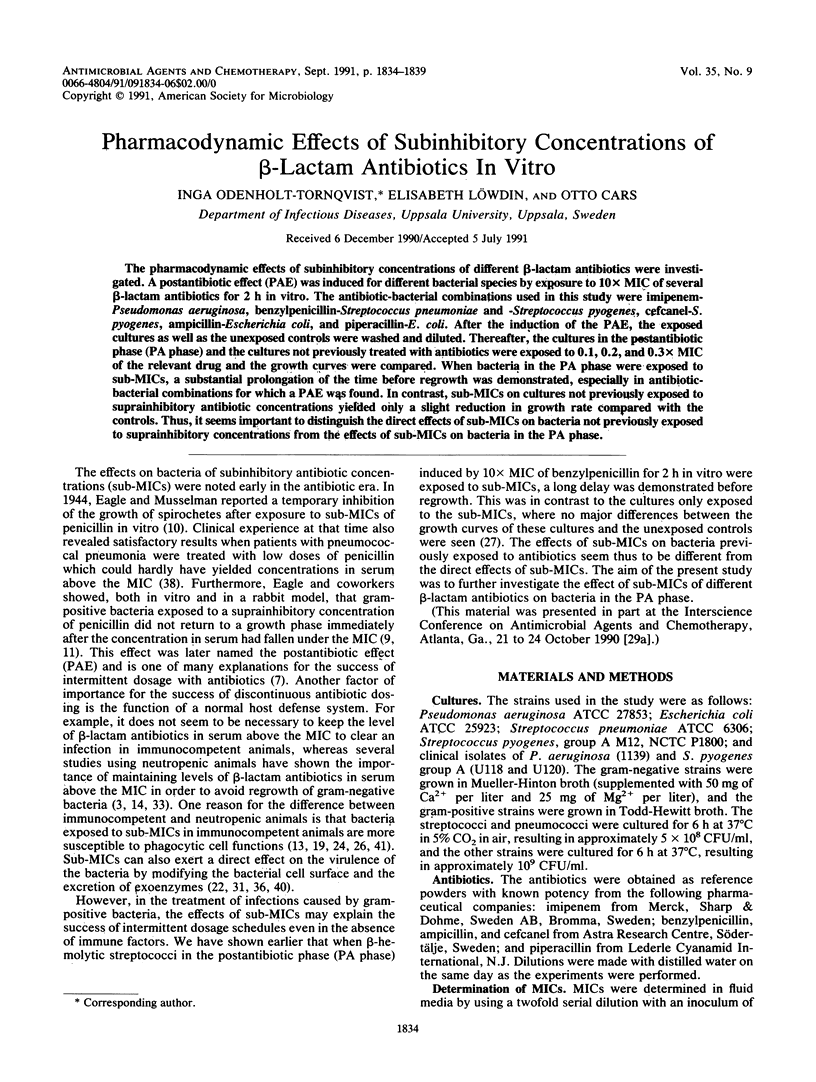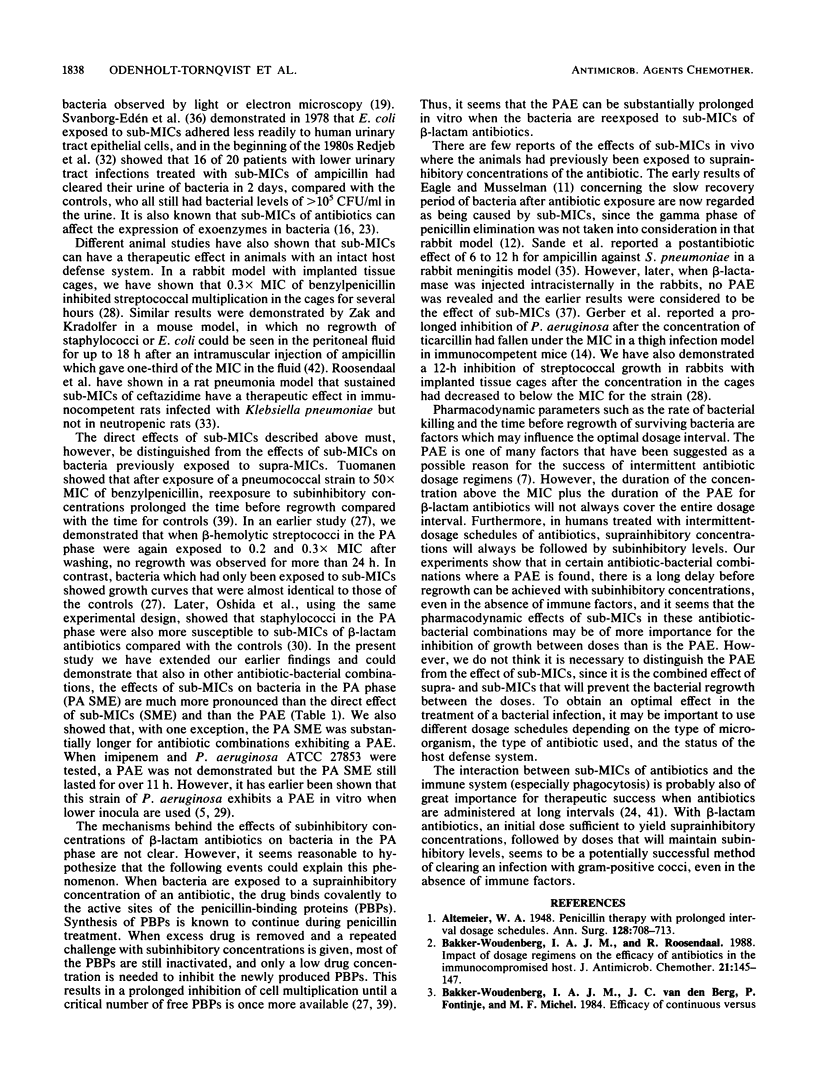Abstract
The pharmacodynamic effects of subinhibitory concentrations of different beta-lactam antibiotics were investigated. A postantibiotic effect (PAE) was induced for different bacterial species by exposure to 10x MIC of several beta-lactam antibiotics for 2 h in vitro. The antibiotic-bacterial combinations used in this study were imipenem-Pseudomonas aeruginosa, benzylpenicillin-Streptococcus pneumoniae and -Streptococcus pyogenes, cefcanel-S. pyogenes, ampicillin-Escherichia coli, and piperacillin-E. coli. After the induction of the PAE, the exposed cultures as well as the unexposed controls were washed and diluted. Thereafter, the cultures in the postantibiotic phase (PA phase) and the cultures not previously treated with antibiotics were exposed to 0.1, 0.2, and 0.3x MIC of the relevant drug and the growth curves were compared. When bacteria in the PA phase were exposed to sub-MICs, a substantial prolongation of the time before regrowth was demonstrated, especially in antibiotic-bacterial combinations for which a PAE was found. In contrast, sub-MICs on cultures not previously exposed to suprainhibitory antibiotic concentrations yielded only a slight reduction in growth rate compared with the controls. Thus, it seems important to distinguish the direct effects of sub-MICs on bacteria not previously exposed to suprainhibitory concentrations from the effects of sub-MICs on bacteria in the PA phase.
Full text
PDF





Selected References
These references are in PubMed. This may not be the complete list of references from this article.
- Altemeier W. A. Penicillin Therapy with Prolonged Interval Dosage Schedules. Ann Surg. 1948 Oct;128(4):708–713. doi: 10.1097/00000658-194810000-00006. [DOI] [PMC free article] [PubMed] [Google Scholar]
- Bakker-Woudenberg I. A., Roosendaal R. Impact of dosage regimens on the efficacy of antibiotics in the immunocompromised host. J Antimicrob Chemother. 1988 Feb;21(2):145–147. doi: 10.1093/jac/21.2.145. [DOI] [PubMed] [Google Scholar]
- Bakker-Woudenberg I. A., van den Berg J. C., Fontijne P., Michel M. F. Efficacy of continuous versus intermittent administration of penicillin G in Streptococcus pneumoniae pneumonia in normal and immunodeficient rats. Eur J Clin Microbiol. 1984 Apr;3(2):131–135. doi: 10.1007/BF02014330. [DOI] [PubMed] [Google Scholar]
- Barza M. A critique of animal models in antibiotic research. Scand J Infect Dis Suppl. 1978;(14):109–117. [PubMed] [Google Scholar]
- Bustamante C. I., Drusano G. L., Tatem B. A., Standiford H. C. Postantibiotic effect of imipenem on Pseudomonas aeruginosa. Antimicrob Agents Chemother. 1984 Nov;26(5):678–682. doi: 10.1128/aac.26.5.678. [DOI] [PMC free article] [PubMed] [Google Scholar]
- Cars O. Pharmacokinetics of antibiotics in tissues and tissue fluids: a review. Scand J Infect Dis Suppl. 1990;74:23–33. [PubMed] [Google Scholar]
- EAGLE H., FLEISCHMAN R., LEVY M. "Continuous" vs. "discontinuous" therapy with penicillin; the effect of the interval between injections on therapeutic efficacy. N Engl J Med. 1953 Mar 19;248(12):481–488. doi: 10.1056/NEJM195303192481201. [DOI] [PubMed] [Google Scholar]
- EAGLE H., FLEISCHMAN R., MUSSELMAN A. D. The bactericidal action of penicillin in vivo: the participation of the host, and the slow recovery of the surviving organisms. Ann Intern Med. 1950 Sep;33(3):544–571. doi: 10.7326/0003-4819-33-3-544. [DOI] [PubMed] [Google Scholar]
- Eagle H., Musselman A. D. THE SLOW RECOVERY OF BACTERIA FROM THE TOXIC EFFECTS OF PENICILLIN. J Bacteriol. 1949 Oct;58(4):475–490. doi: 10.1128/jb.58.4.475-490.1949. [DOI] [PMC free article] [PubMed] [Google Scholar]
- Ebert S. C., Leggett J., Vogelman B., Craig W. A. Evidence for a slow elimination phase for penicillin G. J Infect Dis. 1988 Jul;158(1):200–202. doi: 10.1093/infdis/158.1.200. [DOI] [PubMed] [Google Scholar]
- Gemmell C. G., Peterson P. K., Schmeling D., Kim Y., Mathews J., Wannamaker L., Quie P. G. Potentiation of opsonization and phagocytosis of Streptococcus pyogenes following growth in the presence of clindamycin. J Clin Invest. 1981 May;67(5):1249–1256. doi: 10.1172/JCI110152. [DOI] [PMC free article] [PubMed] [Google Scholar]
- Gerber A. U., Brugger H. P., Feller C., Stritzko T., Stalder B. Antibiotic therapy of infections due to Pseudomonas aeruginosa in normal and granulocytopenic mice: comparison of murine and human pharmacokinetics. J Infect Dis. 1986 Jan;153(1):90–97. doi: 10.1093/infdis/153.1.90. [DOI] [PubMed] [Google Scholar]
- Greenwood D. In vitro veritas? Antimicrobial susceptibility tests and their clinical relevance. J Infect Dis. 1981 Oct;144(4):380–385. doi: 10.1093/infdis/144.4.380. [DOI] [PubMed] [Google Scholar]
- Grimwood K., To M., Rabin H. R., Woods D. E. Inhibition of Pseudomonas aeruginosa exoenzyme expression by subinhibitory antibiotic concentrations. Antimicrob Agents Chemother. 1989 Jan;33(1):41–47. doi: 10.1128/aac.33.1.41. [DOI] [PMC free article] [PubMed] [Google Scholar]
- Kunin C. M. Dosage schedules of antimicrobial agents: a historical review. Rev Infect Dis. 1981 Jan-Feb;3(1):4–11. doi: 10.1093/clinids/3.1.4. [DOI] [PubMed] [Google Scholar]
- Lorian V., Atkinson B. Abnormal forms of bacteria produced by antibiotics. Am J Clin Pathol. 1975 Nov;64(5):678–688. doi: 10.1093/ajcp/64.5.678. [DOI] [PubMed] [Google Scholar]
- Lorian V., Popoola B. The effect of nitrofurantoin on the morphology of gram-negative bacilli. J Infect Dis. 1972 Feb;125(2):187–189. doi: 10.1093/infdis/125.2.187. [DOI] [PubMed] [Google Scholar]
- Lorian V. Some effects of subinhibitory concentrations of antibiotics on bacteria. Bull N Y Acad Med. 1975 Oct;51(9):1046–1055. [PMC free article] [PubMed] [Google Scholar]
- Lorian V., Waluschka A. Blood cultures showing aberrant forms of bacteria. Am J Clin Pathol. 1972 Mar;57(3):406–409. doi: 10.1093/ajcp/57.3.406. [DOI] [PubMed] [Google Scholar]
- Lorian V., Waluschka A., Popoola B. Pneumococcal beta hemolysin produced under the effect of antibiotics. Appl Microbiol. 1973 Feb;25(2):290–294. doi: 10.1128/am.25.2.290-294.1973. [DOI] [PMC free article] [PubMed] [Google Scholar]
- McDonald P. J., Wetherall B. L., Pruul H. Postantibiotic leukocyte enhancement: increased susceptibility of bacteria pretreated with antibiotics to activity of leukocytes. Rev Infect Dis. 1981 Jan-Feb;3(1):38–44. doi: 10.1093/clinids/3.1.38. [DOI] [PubMed] [Google Scholar]
- Merrikin D., Rolinson G. N. Antibiotic levels in experimentally infected mice in relation to therapeutic effect and antibacterial activity in vitro. J Antimicrob Chemother. 1979 Jul;5(4):423–429. doi: 10.1093/jac/5.4.423. [DOI] [PubMed] [Google Scholar]
- Milatovic D. Antibiotics and phagocytosis. Eur J Clin Microbiol. 1983 Oct;2(5):414–425. doi: 10.1007/BF02013898. [DOI] [PubMed] [Google Scholar]
- Müller H. E. Uber das unterschiedliche pathogenetische Verhalten in 171 Salmonella-Serotypen aufgrund ihres Vorkommens in Futtermitteln, Nutztieren und beim Menschen. Infection. 1978;6(3):121–129. doi: 10.1007/BF01642260. [DOI] [PubMed] [Google Scholar]
- Odenholt I., Holm S. E., Cars O. Effects of benzylpenicillin on Streptococcus pyogenes during the postantibiotic phase in vitro. J Antimicrob Chemother. 1989 Aug;24(2):147–156. doi: 10.1093/jac/24.2.147. [DOI] [PubMed] [Google Scholar]
- Odenholt I., Holm S. E., Cars O. Effects of supra- and sub-MIC benzylpenicillin concentrations on group A beta-haemolytic streptococci during the postantibiotic phase in vivo. J Antimicrob Chemother. 1990 Aug;26(2):193–201. doi: 10.1093/jac/26.2.193. [DOI] [PubMed] [Google Scholar]
- Odenholt I., Isaksson B., Nilsson L., Cars O. Postantibiotic and bactericidal effect of imipenem against Pseudomonas aeruginosa. Eur J Clin Microbiol Infect Dis. 1989 Feb;8(2):136–141. doi: 10.1007/BF01963897. [DOI] [PubMed] [Google Scholar]
- Oshida T., Onta T., Nakanishi N., Matsushita T., Yamaguchi T. Activity of sub-minimal inhibitory concentrations of aspoxicillin in prolonging the postantibiotic effect against Staphylococcus aureus. J Antimicrob Chemother. 1990 Jul;26(1):29–38. doi: 10.1093/jac/26.1.29. [DOI] [PubMed] [Google Scholar]
- Raponi G., Keller N., Overbeek B. P., Rozenberg-Arska M., van Kessel K. P., Verhoef J. Enhanced phagocytosis of encapsulated Escherichia coli strains after exposure to sub-MICs of antibiotics is correlated to changes of the bacterial cell surface. Antimicrob Agents Chemother. 1990 Feb;34(2):332–336. doi: 10.1128/aac.34.2.332. [DOI] [PMC free article] [PubMed] [Google Scholar]
- Redjeb S. B., Slim A., Horchani A., Zmerilli S., Boujnah A., Lorian V. Effects of ten milligrams of ampicillin per day on urinary tract infections. Antimicrob Agents Chemother. 1982 Dec;22(6):1084–1086. doi: 10.1128/aac.22.6.1084. [DOI] [PMC free article] [PubMed] [Google Scholar]
- Roosendaal R., Bakker-Woudenberg I. A., van den Berghe-van Raffe M., Michel M. F. Continuous versus intermittent administration of ceftazidime in experimental Klebsiella pneumoniae pneumonia in normal and leukopenic rats. Antimicrob Agents Chemother. 1986 Sep;30(3):403–408. doi: 10.1128/aac.30.3.403. [DOI] [PMC free article] [PubMed] [Google Scholar]
- Ryan D. M., Cars O., Hoffstedt B. The use of antibiotic serum levels to predict concentrations in tissues. Scand J Infect Dis. 1986;18(5):381–388. doi: 10.3109/00365548609032352. [DOI] [PubMed] [Google Scholar]
- Sande M. A., Korzeniowski O. M., Allegro G. M., Brennan R. O., Zak O., Scheld W. M. Intermittent or continuous therapy of experimental meningitis due to Streptococcus pneumoniae in rabbits: preliminary observations on the postantibiotic effect in vivo. Rev Infect Dis. 1981 Jan-Feb;3(1):98–109. doi: 10.1093/clinids/3.1.98. [DOI] [PubMed] [Google Scholar]
- Tuomanen E. Newly made enzymes determine ongoing cell wall synthesis and the antibacterial effects of cell wall synthesis inhibitors. J Bacteriol. 1986 Aug;167(2):535–543. doi: 10.1128/jb.167.2.535-543.1986. [DOI] [PMC free article] [PubMed] [Google Scholar]
- Tylewska S., Hjertén S., Wadström T. Effect of subinhibitory concentrations of antibiotics on the adhesion of Streptococcus pyogenes to pharyngeal epithelial cells. Antimicrob Agents Chemother. 1981 Nov;20(5):563–566. doi: 10.1128/aac.20.5.563. [DOI] [PMC free article] [PubMed] [Google Scholar]
- Täuber M. G., Zak O., Scheld W. M., Hengstler B., Sande M. A. The postantibiotic effect in the treatment of experimental meningitis caused by Streptococcus pneumoniae in rabbits. J Infect Dis. 1984 Apr;149(4):575–583. doi: 10.1093/infdis/149.4.575. [DOI] [PubMed] [Google Scholar]
- Van der Auwera P. Interactions between antibiotics and phagocytosis in bacterial killing. Scand J Infect Dis Suppl. 1990;74:42–48. [PubMed] [Google Scholar]
- Zak O., Kradolfer F. Effects of subminimal inhibitory concentrations of antibiotics in experimental infections. Rev Infect Dis. 1979 Sep-Oct;1(5):862–879. doi: 10.1093/clinids/1.5.862. [DOI] [PubMed] [Google Scholar]


